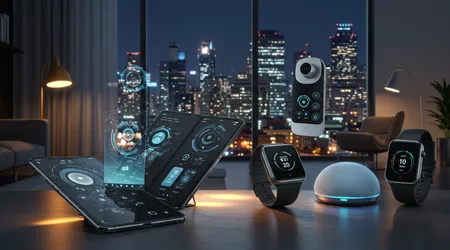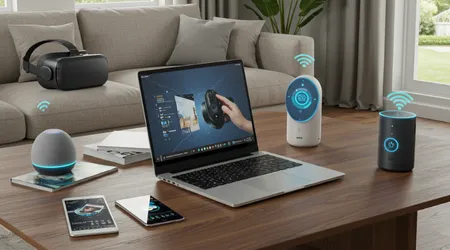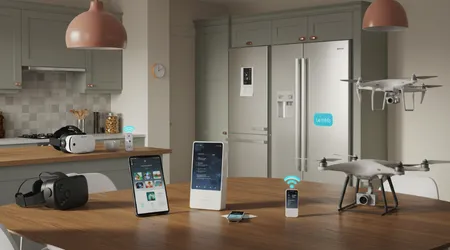Trends in gadgets and connected devices: what to expect from the tech market this year

Trends in gadgets and connected devices are shaping a dynamic tech landscape, promising innovation and disruption in 2025.
From AI-powered wearables to sustainable smart home solutions, the UK’s tech market is buzzing with advancements that blend functionality with human-centric design.
This year, expect devices that not only enhance connectivity but also redefine how we interact with our environment.
With consumer demand for seamless integration and eco-conscious tech soaring, manufacturers are under pressure to deliver.
Are we ready for a world where our gadgets anticipate our needs before we do?
Let’s dive into the key trends driving this transformation, exploring their implications with a critical eye on what’s practical, desirable, and truly revolutionary.
The Rise of AI-Driven Wearables
Wearables are no longer just fitness trackers; they’re becoming intelligent companions. In 2025, trends in gadgets and connected devices spotlight AI-driven wearables that adapt to users’ habits.
Think smartwatches that adjust notifications based on your stress levels, using biometric data to prioritise mental health.
Apple’s latest Watch Series, for instance, integrates AI to optimise battery life by predicting usage patterns, a move informed by user data analysis (Bloomberg, 12 May 2025).
This shift reflects a broader push towards personalised tech, where devices learn and evolve with us.
The practical implications are profound. Imagine a wearable that nudges you to hydrate during a hectic workday, based on real-time health metrics.
++ Record Heatwaves and Wildfires Spark Urgent Debate on Climate Policy and Preparedness
Yet, privacy concerns loom large how much data are we willing to share for convenience?
Manufacturers must balance innovation with trust, ensuring robust encryption and transparent data policies to win consumer confidence.
Another angle is accessibility. AI wearables are now designed with inclusivity in mind, offering features like real-time audio descriptions for visually impaired users.
This trend not only enhances functionality but also broadens the market, making tech a tool for empowerment across diverse demographics.

Smart Homes: Sustainability Meets Connectivity
The smart home sector is undergoing a green revolution, with trends in gadgets and connected devices emphasising sustainability.
Devices like the Shark CryoGlow, with its energy-efficient cooling modes, highlight a shift towards eco-friendly design (Esquire, 15 April 2025).
Consumers are demanding gadgets that reduce carbon footprints while maintaining seamless connectivity. Smart thermostats, for example, now use AI to optimise energy use, cutting bills and emissions simultaneously.
Also read: Russian Spy Ring Leader Sentenced: What the Verdict Means for UK Security
Consider the analogy of a smart home as a living organism, adapting to its inhabitants’ needs while conserving resources.
This year, expect more devices with solar-powered options or recyclable materials.
However, the challenge lies in affordability sustainable tech often comes with a premium price tag, potentially alienating budget-conscious buyers. Manufacturers must innovate to make green tech accessible without compromising quality.
Integration is another focus. Smart home hubs now connect disparate devices lights, locks, appliances into cohesive ecosystems.
Yet, interoperability issues persist. A unified standard could unlock the full potential of smart homes, ensuring your fridge talks to your thermostat without a hitch.
| Device Type | Key Feature | Energy Efficiency | Market Growth (2025) |
|---|---|---|---|
| Smart Thermostat | AI-driven temperature control | Up to 20% energy savings | 15% YoY increase |
| Smart Lighting | Voice-activated dimming | 30% less power usage | 12% YoY increase |
| Smart Locks | Biometric access | Low-power Bluetooth | 10% YoY increase |
The Evolution of Connected Entertainment
Entertainment gadgets are getting smarter, with trends in gadgets and connected devices redefining leisure.
Take the latest karaoke machines, like those from Tom’s Lab, which sync lyrics via AirPlay and Spotify Connect for immersive experiences (Esquire, 15 April 2025).
These devices aren’t just toys; they’re social hubs, bringing people together through shared experiences. Picture a family gathering where everyone sings along, lyrics flashing in perfect sync tech enhancing human connection.
Read more: Live Updates: Key Political Developments Shaping Today’s Headlines
Streaming devices are also evolving. The new Nintendo Switch, set for release this year, integrates cloud gaming with AI-enhanced graphics, offering lag-free play.
But there’s a catch: high-speed internet is a prerequisite, potentially excluding rural UK households. Bridging this digital divide is critical for equitable access to next-gen entertainment.
Moreover, voice-activated devices are transforming how we consume media. Smart speakers now double as personal DJs, curating playlists based on mood or past preferences.
Yet, over-reliance on voice tech risks creating a monoculture of algorithm-driven content will we lose the joy of discovering something unexpected?

5G and IoT: The Backbone of Connectivity
The rollout of 5G across the UK is supercharging trends in gadgets and connected devices, enabling faster, more reliable IoT ecosystems.
From smart fridges that order groceries to connected cars that predict maintenance needs, 5G’s low latency is a game-changer.
A 2025 Ofcom report predicts 80% of UK households will have at least one IoT device by year-end, driven by 5G’s expansion. This connectivity fuels real-time data exchange, making devices smarter and more responsive.
For example, consider a smart insulin pump that adjusts doses based on real-time glucose readings, communicated instantly via 5G. Such innovations save lives, but they also raise cybersecurity concerns.
A single breach could expose sensitive health data. Robust encryption and regular software updates are non-negotiable to protect users.
The IoT boom also extends to urban planning. Smart cities are emerging, with connected traffic lights optimising flow based on real-time data.
Yet, infrastructure costs are steep, and public funding debates could slow progress. The question remains: can the UK balance innovation with equitable access?
The Role of AI in Content Creation and SEO
Beyond hardware, trends in gadgets and connected devices intersect with digital marketing, particularly SEO.
AI tools like ChatGPT are revolutionising content creation, generating blogs and social media captions tailored for search engines (TechRound, 10 April 2025).
These tools analyse user intent, ensuring content aligns with queries like “best smart speaker 2025.” But over-reliance on AI risks diluting authenticity readers crave human insight, not just optimised text.
For instance, a UK tech blog might use AI to draft a review of a new smart thermostat, but human editors add personal anecdotes, like how it saved £50 on winter heating.
This blend of tech and touch keeps content relatable. However, Google’s 2025 algorithms prioritise first-hand expertise, meaning brands must showcase real-world testing to rank high.
Community engagement is another SEO trend. With forums like Reddit gaining search visibility, brands are posting authentic content there to attract users wary of AI-generated fluff.
This shift demands a rethink: how do we create content that’s both optimised and genuinely engaging?
Privacy and Ethics in a Connected World
As trends in gadgets and connected devices accelerate, privacy concerns take centre stage.
Devices collecting biometric data, like heart rate or sleep patterns, raise questions about consent and security.
Apple’s move to analyse user data on-device rather than in the cloud is a step towards privacy-first design (Bloomberg, 14 April 2025). But not all companies follow suit, and lax regulations could leave users vulnerable.
Consider a smart doorbell that records visitors’ faces. It’s convenient but could be misused without clear consent protocols.
Ethical design must prioritise user control, with opt-in data sharing and transparent policies. Consumers are savvier now, demanding accountability brands ignoring this risk losing trust.
Moreover, the environmental impact of connected devices is under scrutiny. E-waste from outdated gadgets is a growing problem, with only 17% of UK tech recycled properly in 2024.
Manufacturers must innovate with modular, repairable designs to reduce waste and meet consumer expectations for ethical tech.

The Future of Work: Gadgets as Productivity Tools
In the workplace, trends in gadgets and connected devices are redefining productivity.
Microsoft’s Work Trend Index predicts a rise in “frontier firms” where workers manage AI agents via smart devices (The Guardian, 25 April 2025).
Picture a project manager using a tablet to delegate tasks to AI bots, streamlining workflows.
This shift boosts efficiency but risks dehumanising work can tech enhance productivity without eroding creativity?
Wearable productivity tools are also gaining traction. Smart glasses with AR displays allow remote collaboration, overlaying project data in real time.
For instance, a UK architect could review site plans hands-free, boosting accuracy. Yet, high costs and learning curves may limit adoption, especially for small businesses.
Training is another frontier. Connected devices now offer VR-based simulations, like a virtual lab for engineers to test designs.
This reduces costs but requires robust cybersecurity to protect proprietary data. As workplaces evolve, balancing tech with human oversight will be key.
Conclusion: Navigating the Tech Tide
The trends in gadgets and connected devices in 2025 paint a picture of a tech market that’s both thrilling and challenging.
From AI wearables that anticipate our needs to sustainable smart homes, the UK is at the forefront of innovation.
Yet, with great power comes great responsibility privacy, accessibility, and ethics must guide this evolution.
The statistic that 80% of UK households will own an IoT device by year-end underscores the urgency of addressing these issues (Ofcom, 2025). Like a river carving new paths, technology is reshaping our lives our job is to steer it wisely.
As consumers, we hold the power to demand tech that’s innovative, inclusive, and responsible. What will you prioritise in this connected future?
Frequently Asked Questions
1. How can I ensure my smart devices are secure?
Use strong, unique passwords, enable two-factor authentication, and regularly update firmware. Check privacy settings to limit data sharing.
2. Are sustainable gadgets worth the higher cost?
They often save money long-term through energy efficiency. For example, a smart thermostat can cut heating bills by 20%, offsetting initial costs.
3. What’s the best way to stay updated on gadget trends?
Follow reputable UK tech blogs, subscribe to newsletters like TechRound, and engage with communities on platforms like Reddit for real-time insights.
4. Can AI wearables improve mental health?
Yes, devices like smartwatches can monitor stress and suggest mindfulness exercises, but they’re not substitutes for professional care.
5. How do I recycle old gadgets responsibly?
Use certified e-waste recycling programs, like those offered by Currys or local councils, to ensure proper disposal and data wiping.
